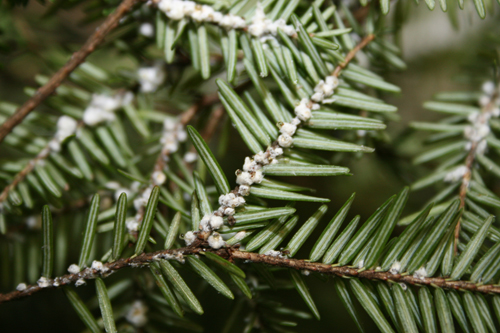Thousands of broken trees line the banks of the Chattooga River. The dead, gray stabs were once evergreen monsters offering shade to trout and picturesque views to visitors. These Eastern hemlocks are native to north Georgia, but they are dying rapidly.
One tiny insect, the hemlock woolly adelgid, is to blame.
“Probably 70 or 80 percent of the trees are dead along the river,” said Jim Hanula, research entomologist with the U.S. Forest Service. “It is a matter of time. Eventually it will kill most of the hemlock trees.”
The Asian insect first appeared in the eastern United States in Roanoke, Va., in the 1950s. It headed north in the late ‘80s. In 2003, it crossed the river from South Carolina and started feeding on Georgia trees.
“Hemlock woolly adelgids are working their way to the western extension of the state,” said Wayne Berisford, a retired University of Georgia entomology professor. “They haven’t occupied all of the possible range yet, but they are approaching.”
The tiny pests suck up cells from the tree’s needles, which prevents them from transferring water and conducting photosynthesis.
The first obvious sign of an infestation is thinning foliage. Needles fall off, and the crown starts thinning. From a distance, trees look gray. The trees may uproot or fall apart, filling nearby streams with debris, blocking the waterway and altering trout habitat.
“The hemlock is a unique tree,” Berisford said. “It will grow in dense shade. It grows well in poor soil by mountain streams and cools the streams for trout.”
Bersiford has worked with Hanula and other researchers to find ways to combat the adelgid. Their main emphasis has been releasing ladybird beetles, which eat adelgids.
“One beetle species has been established, and populations are growing, but we don’t have any evidence they are controlling the adelgids yet,” Hanula said.
Many groups are releasing adelgid predators, including Young Harris College and North Georgia College and State University. Berisford was part of the initial UGA group to release the beetles in 2004 and was instrumental in getting a beetle-rearing lab at UGA.
“Anytime you release another exotic you are taking a bit of a chance,” Berisford said. “But these predators have been screened thoroughly. If you offer prey other than the hemlock woolly adelgid, they will literally starve to death.”
Berisford said it is typical with a biological control not to see immediate results.
“The fact that a population is established is encouraging, but I don’t know what it means,” Berisford said. “We are all hoping this will be a successful venture.”
Labs are evaluating new insects but must complete a battery of tests before they can release the predators.
Chemical controls are available, although difficult to dispense in the forest.
“There are materials available for homeowners to use to combat these insects,” said Kris Braman, an entomologist with the UGA College of Agricultural and Environmental Sciences.
Homeowners should look for products with imidacloprid or dinotefuran as their active ingredients. Different formulations are available for drench or granular applications. A few products are Safari and Bayer Advance Garden Tree and Shrub Insect Control. Foliar spray applications of insecticidal soaps or oils can be immediately effective, but only work for a short time.
“There are a series of options, but probably the most effective and most persistent is a systemic insecticide, which is transmitted through the tree and reaches the new growth the insects attack,” Braman said. “The Bayer Advance can be slow to act, but is persistent for several years. Insecticidal soap would need to be reapplied fairly frequently. Safari is quicker acting, but may only last two years.”
Hemlock species differ in their susceptibility to the insect, which offers hope for plant breeders to find resistant genes and produce trees the insects can’t kill. But until then, Georgia’s hemlocks are on the menu and in danger.









